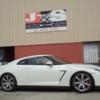There Should Be An R35 Gt-t
Announcements
-
Similar Content
-
Latest Posts
-
From my youth: GTi-R clutch change is a massive pain. The gearboxes are fragile? But the car is super cool and I want one 😢
-
By TurboTapin · Posted
Driveline vibration is resolved. I ended up loosening all my engine mount and trans mount bolts, giving it a good shake then retightening everything and it's gone... Let's just say I was surprised that fixed it. I've been happily driving it around again but unfortunately put zero time into my direct port/constant pressure WMI setup. I'm on vacation next week, so I'll try and finalize it then. On a different note, I spent all week fuel/ignition mapping 2x 216L V16 engines. Turbo's were burning glycol and we swapped them out for larger units. We also had planned emissions testing on site, so I figured I'd be there the same week to use their instrumentation and massage any emissions issues out if needed. This was a first for me. Fuel management is similar in certain ways to automotive (i.e air density as load variable) but very different in others. It's all PLC based and AFR's are controlled by air and not fuel. They use a control valve between the turbo and air manifold to control pressure which in turn controls AFR's. Due to this, target AFR tables supplied by the OEM are in pressures and not mass which really through me off. They use air pressure vs fuel pressure tables. I also relied on an O2 concentration sensor the emissions team had in the exhaust. Ignition timing was also all over the place and we were losing a fair bit of power. They're now happily sitting at 16-40BTDC depending on load. We were making about 1600kw at 900rpm at 90% load. Engines were running a lot smoother as well. -
heh, aint no R32 ever meeting modern targa cage rules unless the driver is veeeery short OP, good luck with the sale, since its already in the land of freedom I'm sure you will find a good buyer.
-
meh, it was a good video, clear about the issue and how he dealt with it. A bit heavy on the RTV and very brave to put an RB in anything without rebuilding it first, but otherwise I thought it was good Dose, I'm not sure that having the pickup forward is a big issue; yes of course the oil could shift under brakes but the sump should never be empty enough for that to be a problem (unless you also have a higher volume oil pump, and that oil can't return from the head to the sump quickly enough)
-






Recommended Posts
Create an account or sign in to comment
You need to be a member in order to leave a comment
Create an account
Sign up for a new account in our community. It's easy!
Register a new accountSign in
Already have an account? Sign in here.
Sign In Now